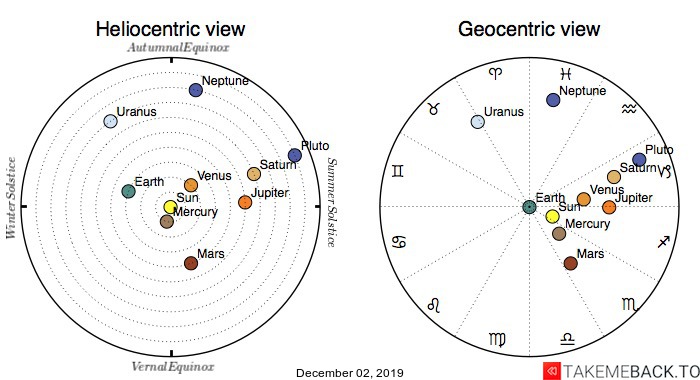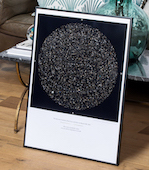Horoscope, Numerology and Moon Sign on December 2nd, 2019
The horoscope on December 2nd, 2019 is the personalized astrological chart or diagram that represents the positions of celestial bodies, such as the Sun, Moon, planets, and astrological points, at a specific time, usually the moment of a person's birth.
The generated horoscope could offer guidance, predictions, or simply serve as a tool for self-reflection, depending on the user's preferences and beliefs in astrology.
If you are born on December 2nd, 2019 in this page you'll also discover your special number according to Numerology, your Moon Sign, your Chinese Zodiac sign and Birth Chart..
Table of contents
- What is the horoscope of someone born on December 2nd, 2019?
- What are the moon phase and moon sign for people born on December 2nd, 2019?
- According to numerology, what is the number for people born on December 2nd, 2019?
- What is the Chinese Zodiac Sign for people born on December 2nd, 2019?
- What is the Birth Chart for people born on December 2nd, 2019?
- Famous people born on December 2nd, 2019
What is the horoscope of someone born on December 2nd, 2019?
Zodiac sign
Symbol
Ruling Planet
Associated Element
Fire
Personality Traits:
Individuals born on Monday, December 2, 2019, under the Sagittarius zodiac sign, are known for their adventurous spirit, intellectual curiosity, and a strong sense of independence. They are often described as free-spirited, optimistic, and always eager to explore new horizons. Their Monday birth adds a touch of practicality and organization to their otherwise spontaneous nature, making them well-equipped to balance their thirst for adventure with a more grounded approach to life.
Love Compatibility:
In matters of love, Sagittarians born on this date are highly compatible with Aries, Leo, and Aquarius. Their shared sense of adventure and desire for freedom create a natural understanding and harmony. However, they may struggle with the more emotional and sensitive signs, such as Cancer and Pisces, as their need for independence can clash with the desire for deeper emotional connections. Establishing a balance between their need for freedom and their partner's need for security is crucial for these Sagittarians.
Who should a Sagittarius marry?
Career and Money:
Professionally, Sagittarians born on December 2, 2019, thrive in careers that allow them to utilize their intellectual abilities and explore new ideas. They excel in fields such as education, journalism, law, or any industry that involves travel, research, or problem-solving. Their ability to think outside the box and their natural entrepreneurial spirit can also lead them to successful business ventures. Financially, they tend to be prudent and responsible, but their love for adventure may sometimes lead to impulsive spending.
Health:
These Sagittarians generally enjoy good health, thanks to their active lifestyles and positive outlook on life. However, they may be prone to overexerting themselves or neglecting their physical well-being in pursuit of their many interests. Maintaining a balanced diet, regular exercise, and taking time for rest and relaxation are essential for their overall well-being.
Family:
Family is important to Sagittarians born on December 2, 2019, but they may struggle to find the right balance between their need for independence and their family responsibilities. They value quality time with their loved ones and are often the ones who plan family outings or gatherings. However, they may also need to set boundaries to ensure their personal freedom is respected.
Friends:
Sagittarians born on this date are highly social and enjoy the company of a diverse group of friends. They are often the life of the party, bringing their infectious enthusiasm and sense of adventure to their social circles. Their friends appreciate their open-mindedness, sense of humor, and willingness to try new things. However, they may need to be mindful of not neglecting their close friendships in pursuit of their many interests.
Born on a different day? Use our free calculator to find out your zodiac sign and horoscope on any day.
What are the moon phase and moon sign for people born on December 2nd, 2019?
For individuals born on December 2nd, 2019, the Moon Phase is Waxing crescent. To determine your Moon sign if you're born on December 2nd, 2019 you'd need the specific time and location of birth: use this free tool to discover your Moon Sign!
According to numerology, what is the number for people born on December 2nd, 2019?
To calculate the numerology number for someone born on December 2nd, 2019, we add up the individual digits of the birth date and reduce it to a single-digit or a master number.
Let's calculate it:
December 2nd, 2019
12 (Month) + 2 (Day) + 2 + 0 + 1 + 9 (year) = 8
What is behind this number? Get your Numerology reading if you are born on December 2nd, 2019
What is the Chinese Zodiac Sign for people born on December 2nd, 2019?
For individuals born on December 2nd, 2019, their Chinese Zodiac sign is the Pig. In the Chinese Zodiac, each year is associated with a specific animal, and 2019 is the Year of the Pig. Calculate Your Chinese Zodiac Sign.
What is the Birth Chart for people born on December 2nd, 2019?
The birth chart of people born on December 2nd, 2019 also known as a natal chart, is a personalized astrological map representing the positions of celestial bodies at the exact time and location of an individual's birth. An observer located in New York City on Monday December 2, 2019, would see the planets as depicted in the following picture:

Find below a detailed table including for each star, satellite and planet rising and setting times and phases.
| Planet | Constellation | Right Ascension | Declination |
|---|---|---|---|
| Mercury | Libra | 15:21:43.31 | -16:29:29.3 |
| Venus | Sagittarius | 18:43:22.96 | -24:36:53.9 |
| Mars | Libra | 14:29:29.97 | -14:06:06.1 |
| Jupiter | Sagittarius | 18:01:08.89 | -23:18:08.9 |
| Saturn | Sagittarius | 19:19:10.97 | -22:06:06.2 |
| Uranus | Aries | 2:04:52.61 | 12:07:25.1 |
| Neptune | Aquarius | 23:09:50.53 | -6:30:14.4 |
| Pluto | Sagittarius | 19:33:28.98 | -22:19:15.2 |
Famous people born on December 2nd, 2019
See what else happened on December 2nd, 2019


